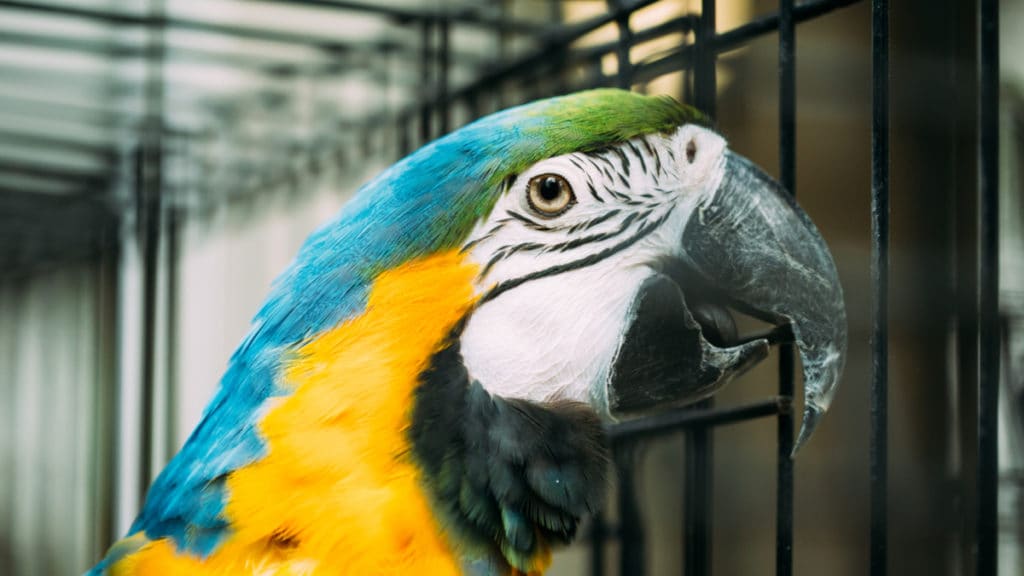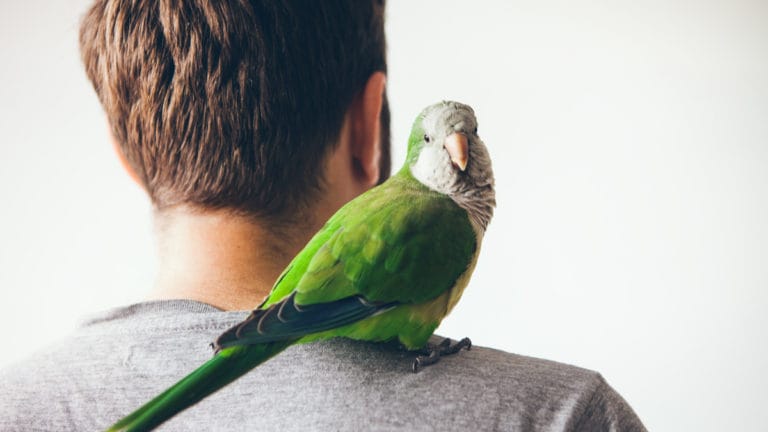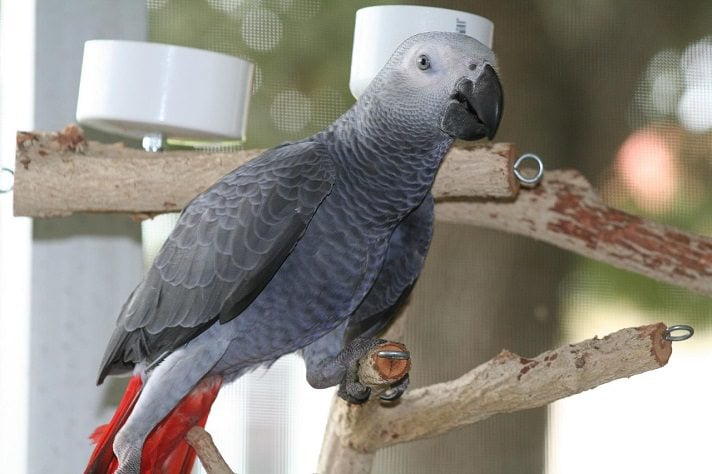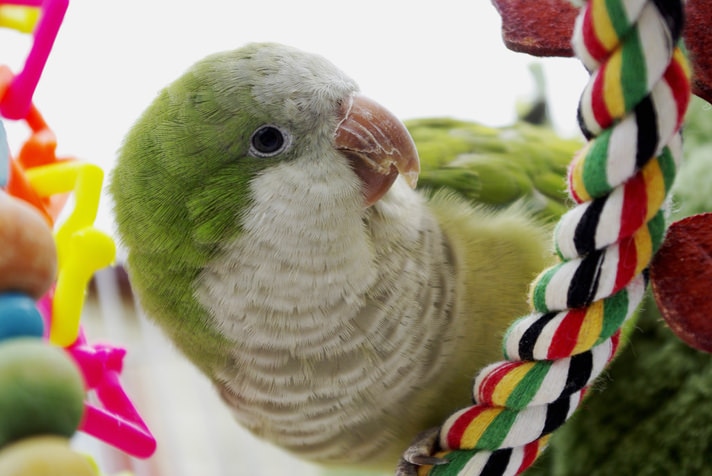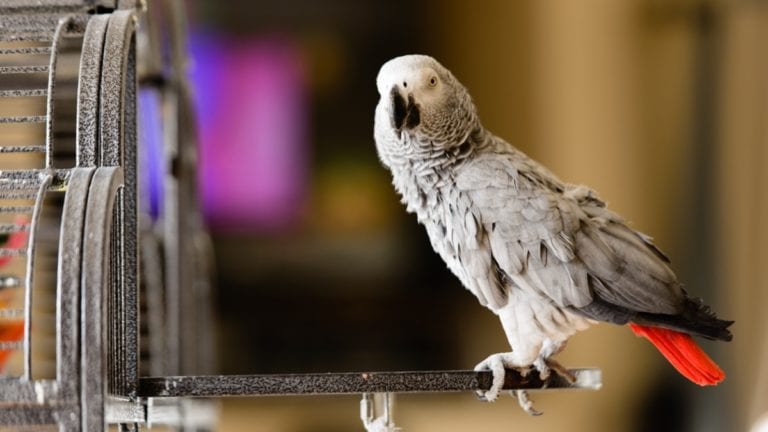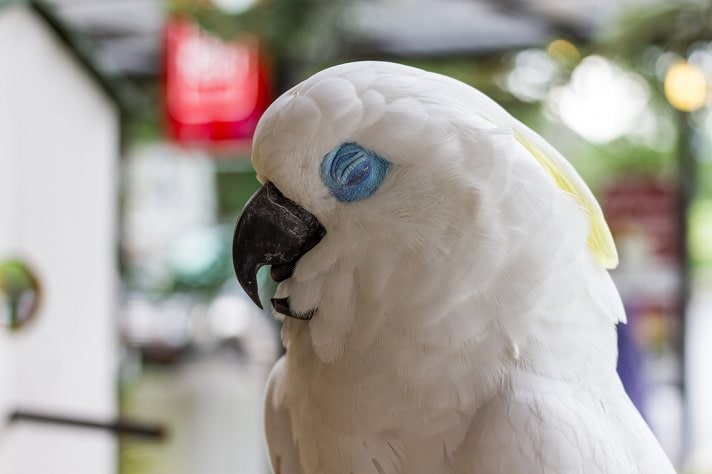The following scenarios describe various manifestations of what are often called cage-bound behaviors that are frequently seen in companion parrots. As with all behaviors, each has a purpose. Nothing happens for no reason, so they become more comprehensible when each scenario is analyzed.
Scenario No. 1
Andrew is a 3-year-old male green-winged macaw. Until recently, he has been eager to exit his bird cage in the morning, but now things have changed considerably. Instead of barreling out of the bird cage the second the door is opened, Andrew retreats to the back of the cage to avoid hands that reach for him. He has also started lunging aggressively at hands when they attempt to provide fresh parrot bird food, water and cage cleaning.
Family members are horrified with the change, and their feelings are hurt by his behavior. They are rapidly losing their pleasure in interacting with their young parrot. Things do not look good for Andrew’s future.
Scenario No. 2
Dobby is a 2-year-old male quaker parrot that has become incredibly aggressive when his owners try to service his cage or bring him out. The owners joke that putting their hand in his cage is rather like putting one’s hand into a functioning garbage disposal. All family members bear the obvious evidence of aggression, as each sports scabs and bruises on hands and arms.
Scenario No. 3
Hobbit is a female lovebird of unknown age. While she is a sweetheart away from her cage, anyone reaching into her domain is likely to bleed for a while. Nicknamed “the shark with feathers,” she sinks her beak into invading fingers and refuses to release. She may be small, but her beak packs quite a wallop. Her owners are rapidly losing interest in handling her.
Scenario No. 4
Angel is a 15-year-old-plus female umbrella cockatoo. Little of her history is known prior to her arrival at a local parrot re-homing facility, but the assumption is that she has been seriously abused. Foster homes are finding it difficult to make any progress with her. She is not at all aggressive, but freezes and quakes with fear if anyone tries to remove her from her cage.
If no one is near by and the cage door is left open, she will eventually creep out very cautiously and sit quietly on the top of the cage toward the back. Any attempts a human might make to approach her result in a quick scurry back inside, where she sits in the back and shivers with terror.
Normal And Natural Parrot Behaviors
In the first three scenarios, the parrots are clearly guarding their turf. Territorial instincts are extremely strong in the avian world and perhaps even stronger than in mammalian species. Some bird species, such as the large macaws, quaker parrots and lovebirds, are especially known for this behavior.
An example of intense territorial behavior is a phenomenon biologists call “mobbing,” which is easily witnessed each spring. Mobbing is the spectacular and risky behavior in which small birds attack and harass much larger and more dangerous predators. It is a common springtime spectacle to see small birds like sparrows and finches attack larger birds like crows and hawks. The same is true with a mockingbird that makes furious (but harmless) diving attacks at a dog, cat or human. This is a perilous business for the attackers, but a wide variety of bird species are driven to this level of territorial behavior every year as they build nests and raise young.
According to Charles Munn, reputed to be the foremost expert on the wild macaws, a lack of a suitable nest site is the No. 1 obstacle to the reproduction of the large macaws of South America. With that in mind, it follows that a macaw is more likely to be able to replace a mate and make more babies than find another appropriate nest site. Therefore, it is understandable that large macaws are particularly prone to aggressive territorial behaviors in captivity. After all, most of the macaws in our homes are, at most, first or second generation from the wild, so captive breeding has not yet diluted this powerful instinct.
Parrots that are communal nesters, like lovebirds, budgerigars (parakeets) and quaker parrots, also tend toward exceptionally aggressive territoriality. This makes perfect sense when viewed from the perspective of carving out their small piece of turf in close proximity with many others of their species. These bird species spend most of their lives guarding their minuscule realms and squabbling with their neighbors, so it’s understandable when they also bicker with humans about their personal space.
Fear-Based Pet Bird Behaviors
Totally different from the first three examples, in Scenario 4. Angel the cockatoo is not defending territory. Instead, she is afraid to leave her cage, and she exhibits a strong avoidance behavior.
Situations like this were commonly seen with imported parrots that were not properly and gently tamed. They appear to have decided that they are only safe around their cages.
This type of behavior is also seen in domestically bred young psittacine birds that ceased to be handled before they had established strong ties to humans. This situation might occur in a pet store that has little understanding of parrots. Not comprehending just how tenuously “tame” a domestic-bred young parrot can be, the store personnel might handle baby parrots only when feeding them. If a parrot then weans prior to being sold, the store employees might cease handling the bird altogether, and the baby then is allowed to slip into a wild state. As previously mentioned, most domestically bred companion parrots are only first or second generation from the wild, so this reversion to the feral state can happen surprisingly quickly.
This fear-based behavior is also seen when parrots are confronted with something they find terrifying. This could include loud, fast-moving children or large, predatory pets.
I vividly remember a severe macaw that would scream hysterically and cling to the back of his cage whenever the owner’s small daughters approached the cage. The parents saw nothing wrong with the kids banging on the cage bars. They scheduled a consult with me because they wanted him to stop screaming. They did not understand why the little macaw was not friendly to the children, assuming the parrot should recognize that they were kids and that he should be patient with them. After all, they said, their 12-year-old golden retriever obviously understood this, and the pet store had told them that parrots were smarter than dogs!
I have also seen this kind of cage defensive behavior in response to overly aggressive owners who have no respect for parrots having their own opinion about things. For example, these people often expect their parrots to submit to things like petting whether the birds enjoy it or not. I call this the “Dog With Feathers Syndrome.”
Since we do not know the little cockatoo’s history, we have no way of knowing why she is behaving as she is. For whatever reason, Angel has learned that she is only safe when firmly attached to her cage. However, in this circumstance, why the behavior developed is not as important as how the situation needs to be handled.
The Polite Approach
Other than emergencies, a companion parrot should never be forced from its cage against its will. That is, after all, quite rude! Instead, it should be offered a choice.
The respectful approach advocated by parrot behavior consultant Chris Davis is much better for the parrot-person relationship. The human approaches the cage and politely asks the bird, “Would you like to come out?” The parrot will answer this question eloquently with its body language. It may move forward eagerly, look hopeful and friendly, and perhaps lift a foot as a positive response. If so, the person can then open the cage door and offer the hand or perch, and say, “Step up.”
However, the bird often has its own opinion about the timing of interactions betwixt parrot and person. It is not, after all, a dog. Perhaps the bird is eating, or playing contently. Perhaps it is pondering a particularly difficult concept of astral physics. For whatever reason, the parrot chooses to politely decline the invitation. Perhaps it moves away, or turns its back. The message is clear. “No, I do not wish to come out right now, thank you.”
Understanding this gracious response, the human goes away and returns perhaps in a few minutes to repeat the request. Since no request has been made for the parrot to Step up, there is no need to follow through. While a firm believer that parrots should be taught to compliantly step on and off the hand when directed to, I also believe that such commands should be used only when the likelihood of obedience is great. In other words, don’t use the word unless it is likely to be met with obedience. This places parrot and person in a win-win situation.
There is a reason behind a parrot refusing to exit its cage. Once the situation is carefully analyzed and a parrot’s motivations better understood, it becomes easier to figure out how to approach a problematic situation.
With birds that have become cage territorial, having a bird perch and/or T-stand training in place neatly steps around the problem. With the frightened bird, teach it that wonderful things happen when it conquers its fears sufficiently. This is the first step toward establishing trust. Whenever possible, use the positive approach with lavish verbal and/or edible rewards and endless patience. You will be rewarded with years of happy companionship with one of Nature’s most extraordinary creatures.
By: Liz Wilson, CVT, CPBC
Share:
